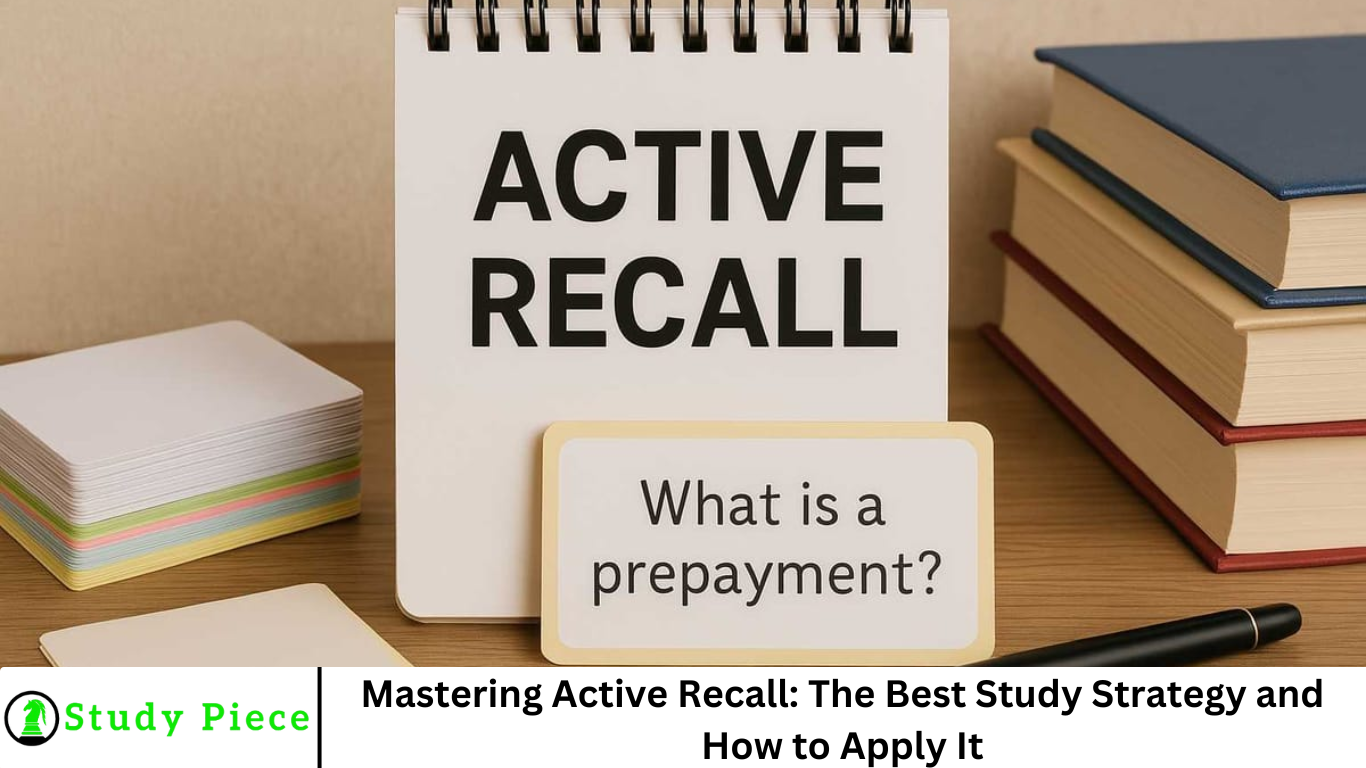Struggling to retain what you learn? If you’re tired of rereading notes or highlighting textbooks without results, it’s time to try a method backed by cognitive science: active recall. In this article, you’ll learn what active recall is, why it’s the most effective study strategy, and how to apply it step by step to get real academic results.
More Read: Mastering the Interleaving Study Method: A Student’s Guide
What Is Active Recall?
Active recall is a study technique that involves retrieving information from memory without looking at your notes or textbooks. Instead of passively reviewing material, you test yourself, forcing your brain to work harder to recall the answer. This strengthens neural connections and improves long-term retention.
It’s not just a theory. Dozens of studies in cognitive psychology show that active recall is more effective than passive study techniques like rereading or highlighting. In fact, one of the most cited studies by Karpicke and Roediger (2008) showed that students who used active recall significantly outperformed those who simply reviewed material.
Why Active Recall Works
The science behind active recall is rooted in the testing effect—a psychological phenomenon where actively retrieving information helps you remember it better in the future. When you recall information, you’re training your brain to access it more efficiently.
Here’s why it’s so powerful:
- Strengthens memory pathways: The more you recall, the stronger the memory becomes.
- Identifies knowledge gaps: You quickly learn what you don’t know, so you can focus on improving weak areas.
- Encourages deeper learning: Instead of recognizing material, you’re forced to produce it, leading to better understanding.
Active Recall vs. Passive Learning
| Method | Description | Effectiveness |
|---|---|---|
| Rereading | Reading notes or textbooks multiple times | Low |
| Highlighting | Marking key points | Low |
| Summarizing | Writing down key concepts in your own words | Moderate |
| Active Recall | Testing yourself from memory | High |
Passive techniques can feel productive, but they’re often deceptive. Just because you recognize information doesn’t mean you know it. Active recall eliminates this illusion and forces your brain to work, which is exactly what builds strong, long-term memories.
How to Apply Active Recall: Step-by-Step Guide
You don’t need fancy tools to start using active recall. Here’s how to apply it effectively in your study routine.
1. Use Flashcards
Flashcards are one of the most popular tools for active recall. Write a question on one side and the answer on the other. Test yourself regularly, and use tools like Anki or Quizlet that incorporate spaced repetition for even better results.
Tips:
- Keep answers concise.
- Mix topics within a session to improve memory (interleaving).
- Use pictures, diagrams, or mnemonics for tougher concepts.
2. Close the Book and Recite
After studying a concept, close your book and try to explain it out loud—as if teaching someone else. This forces you to recall the information and reveals gaps in your understanding.
3. Practice Retrieval with Past Papers
Use practice questions, quizzes, and previous exam papers to simulate real test conditions. Don’t just check answers—write or say them out loud before verifying.
4. Create Your Own Questions
While reading a textbook or taking notes, pause frequently and write down potential test questions. Later, quiz yourself using these questions.
5. Utilize the “Blurting” Technique
After a study session, take a blank sheet of paper and write down everything you remember about the topic—without looking at your notes. Then, check what you missed and repeat the process. This method is simple but highly effective.
Combining Active Recall with Spaced Repetition
To get the most out of active recall, combine it with spaced repetition—a technique that involves reviewing information at increasing intervals over time. This ensures you don’t forget what you’ve learned and strengthens your memory even further.
Example Spaced Review Schedule:
- Day 1: Learn and test
- Day 2: Test again
- Day 4: Test again
- Day 7: Review once more
- Day 14: Final review
Apps like Anki are excellent for this because they automate the schedule based on how well you remember each flashcard.
Active Recall Tips for Different Subjects
Science & Math:
- Use flashcards for formulas, definitions, and problem-solving steps.
- Solve problems without looking at notes, then check your process.
History:
- Create timeline flashcards and test yourself on events and dates.
- Practice writing essays from memory using key points.
Languages:
- Use flashcards for vocabulary and grammar rules.
- Try writing sentences or speaking out loud without prompts.
Common Mistakes to Avoid
- Reading before recalling: Don’t cheat! Try to recall from memory first before checking.
- Cramming everything at once: Active recall is most effective over time—not in one marathon session.
- Not reviewing mistakes: Always go back and review what you got wrong to truly learn it.
- Relying only on flashcards: Mix it up with written recall, blurting, and teaching to reinforce learning.
Frequently Asked Question
What is active recall and how does it work?
Active recall is a study technique that involves testing yourself to retrieve information from memory, rather than passively reviewing notes or textbooks. It strengthens neural pathways and improves long-term retention by making your brain work harder to remember information.
Why is active recall better than rereading or highlighting?
While rereading and highlighting feel productive, they’re passive and lead to shallow learning. Active recall forces you to retrieve knowledge, which research shows leads to deeper understanding and stronger memory retention.
How can I start using active recall in my study routine?
Start by using flashcards, practice questions, or writing down everything you remember after reading. Apps like Anki or Quizlet are great tools for structured active recall. Always test yourself before checking the answers.
Can I use active recall with any subject?
Yes! Active recall works across all subjects:
- Use flashcards for vocab in languages,
- Solve problems without notes in math and science,
- Recite key points from memory in history or social studies.
How often should I use active recall?
Use active recall consistently and repeatedly. Combine it with spaced repetition—reviewing information at increasing intervals—to maximize memory retention and avoid cramming.
What tools help with active recall?
Some of the best tools include:
- Anki (for spaced repetition flashcards),
- Quizlet (for ready-made flashcard sets),
- Past exams and practice questions,
- The “blurting” method (writing down everything you remember from memory).
Is active recall time-consuming or difficult?
It can feel harder than passive methods, but that’s the point—it’s more effective because it challenges your brain. Even short sessions of active recall are more efficient and impactful than hours of rereading.
Conclusion
Active recall is more than just a trick—it’s a proven strategy that transforms the way you study. While it can feel harder than passive learning, that extra effort is exactly what makes it effective. Once you develop the habit, you’ll find it easier to learn more in less time, retain knowledge longer, and perform better on exams.



